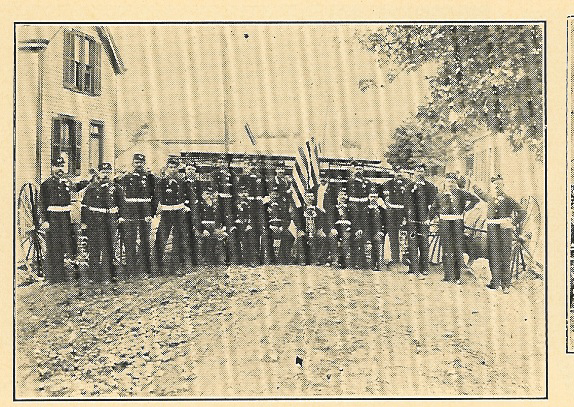HISTORY
In 1794, a German immigrant by the name of Abraham Voorhees moved his family from their home near Philadelphia, building a large double log cabin along the west bank of the Millcreek in Sycamore Township. Shortly after, a visitor from Reading, PA (Harvey Redinbo) was pleased with the land that Voorhees had acquired and purchased his own land, in the area of Hunt Road and Columbia Avenue. This early settlement (1797) was known as Voorhees-Town, but was changed to Reading in the honor of Redinbo’s hometown, and the birthplace of his father-in-law (William Penn, founder of Pennsylvania – born in Reading, England).
By 1809, Reading was a town of two taverns and twenty houses. The 1830 population had reached two hundred with forty five houses, five taverns, two general stores, two wagon shops, two blacksmith shops, two tailors, three shoemakers, a cooperage, and a tannery. Reading gradually grew with it many tailor shops, four breweries, vinegar and woolen mills, yeast factory, three fireworks concerns, a rope factory, brick yard, and planning mill, as well as several taverns and stores. The act of incorporation, as a village, was passed by the Ohio Legislature on March 24, 1851. James Clark was the first Mayor.
 The first record of any organized fire department was in 1886. Street lights, using kerosene as fuel were installed along Main Street. Pedestrians were compelled to carry lanterns when shopping or visiting after dark. A series of devastating fires occurred which were no match for these volunteers who were using hand operated pumps, getting their water from wells and cisterns. In 1892, Mayor Jacob Greiner institutes a $40,000 bond issue to construct water and electric plants. In that same year, the fire department is organized as a Municipal department. In 1902, the Municipal Building is erected at Market and Pike, housing police, fire and other city offices. The building was remodeled in 1950 so that all fire equipment could be stored.
The first record of any organized fire department was in 1886. Street lights, using kerosene as fuel were installed along Main Street. Pedestrians were compelled to carry lanterns when shopping or visiting after dark. A series of devastating fires occurred which were no match for these volunteers who were using hand operated pumps, getting their water from wells and cisterns. In 1892, Mayor Jacob Greiner institutes a $40,000 bond issue to construct water and electric plants. In that same year, the fire department is organized as a Municipal department. In 1902, the Municipal Building is erected at Market and Pike, housing police, fire and other city offices. The building was remodeled in 1950 so that all fire equipment could be stored.
May 7, 1914: Sts. Peter and Paul church is struck by lightning. Firefighters from Reading and Lockland are unable to save the 175 foot bell tower. Firefighters from Cincinnati were called in with a water tower, helping extinguish the fire. The church’s bell tower had been a landmark of the Valley.
 By 1920, Reading’s population had grown to 4,540. In 1926, the fire department receives its first motorized vehicle. The four-cylinder Denby had a chemical tank that had to be inverted to discharge agent through its hose reels. In 1928, the first motorized pumper is purchased. The new Ahrens Fox cost $13,000. The old Ahrens served the department for nearly fifty years before being retired. The rig was refurbished by members of the department in 1976, for the American Bicentennial festivities. The City still owns the rig and it is brought out regularly for special events and parades.
By 1920, Reading’s population had grown to 4,540. In 1926, the fire department receives its first motorized vehicle. The four-cylinder Denby had a chemical tank that had to be inverted to discharge agent through its hose reels. In 1928, the first motorized pumper is purchased. The new Ahrens Fox cost $13,000. The old Ahrens served the department for nearly fifty years before being retired. The rig was refurbished by members of the department in 1976, for the American Bicentennial festivities. The City still owns the rig and it is brought out regularly for special events and parades.
By 1960, the population reached 12,832. The fire department was comprised of 25 men, all paid volunteers. In 1967, the Reading Life Squad was organized and made its first run on July 19, 1967. The service was previously available through Schmidt-Dhonau Funeral Home and the Ohio Valley Life Squad.
Elmer Siebel was appointed the first full-time Fire Chief in January, 1968. One year later, the firehouse is stationed with full-time members: three Lieutenants, one Lt./Inspector, and six firefighters.
By 1976, Reading’s population is estimated around 15, 500. In 1979, three additional firefighters are hired and the Life Squad is moved into the fire department, under the direction of Chief Robert Hollmeyer. With this combination of services, the fire department begins to offer paramedic services. In 1981, the fire department opens a second station on Columbia Avenue, the property obtained from the Sisters of Notre Dame. The City divided by the railroad since 1887, now had fire and EMS equipment located on both sides of the track.
Today, the fire department is a combination department comprised of career, part-time, and paid-on-call members that provides a full range of services to City of Reading and the Village of Arlington Heights. The department also provides emergency medical services to Amberley Village. Chief Todd Owens was appointed on February 23, 2014 and has been a member of the department now for 20 years. The department maintains three pumpers, an aerial ladder truck, medic unit, two ambulances, utility truck and special services trailer (hazmat/rescue). The fire department maintains an ISO rating of 2. Services continue to expand, meeting the needs of an ever changing community.